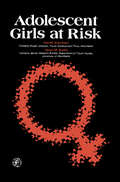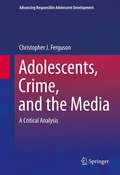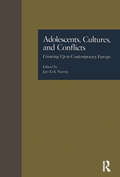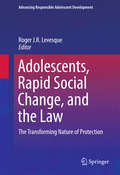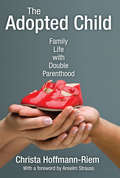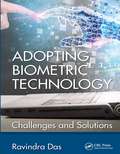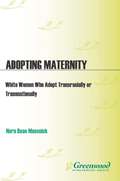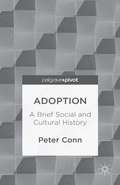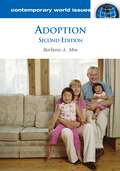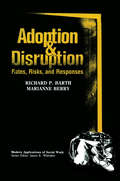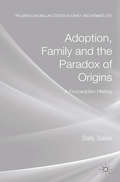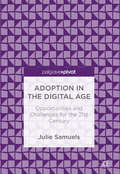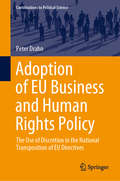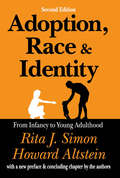- Table View
- List View
Adolescent Girls at Risk
by Harold Marchant Helen M. SmithAdolescent Girls at Risk focuses on a fieldwork that employed measures and programs designed to help girls in their transformation to adolescence. The book first ponders on the theoretical background and plan of the project, including fieldwork aims and methods, research aims and methods, and at risk factors. The text then examines the girls who are the subjects of the study, as well as the start of fieldwork. The book explores the kind of bond and relationship that developed among the girls, particularly the strategies that social workers have employed in assisting them to recognize and achieve personally satisfying relationship with adults, peers, and authority. The manuscript also takes a look at the termination of the project work and research analysis of the fieldwork. The book is a dependable source of information for social workers and researchers interested in studying the transformation of girls to adolescence.
Adolescent Substance Abuse: Evidence-Based Approaches to Prevention and Treatment (Issues in Children's and Families' Lives)
by Carl G. Leukefeld Thomas P. GullottaThe second edition of this book incorporates the latest theory, research, and best practices for understanding, treating, and preventing substance abuse among adolescents. It updates the progress made in treatments for and prevention of the misuse of substances and adds new specific chapters on prescriptions, opiates, and methamphetamine abuse. The book discusses the effects of commonly abused substances, from tobacco and alcohol to stimulants and opioids, on the human brain and the various psychosocial routes to their misuse by adolescents. Chapters provide evidence-based guidelines for assessing adolescent treatment needs and review psychological, pharmacological, family, and self-help interventions. The book offers new paths in diverse directions, analyzes the core components of substance use prevention, critiques emerging school-based interventions, and introduces a nuanced reconceptualization of recovery.Topics featured in the book include:The effect of family and caregiver situations on adolescent substance abuse.A biological/genetic perspective on adolescent substance abuse.School-based preventions and the evolution of evidence-based strategies.The role of adolescent self-help in substance abuse interventions.Community-based interventions to reduce alcohol use and misuse. Adolescent Substance Abuse, Second Edition, is a must-have reference for researchers, clinicians/practitioners, and graduate students in the fields of child and school psychology, social work, public health, developmental psychology, child and adolescent psychiatry, and various interrelated mental health and social policy arenas.
Adolescent-to-Parent Violence and Abuse: Applying Research to Policy and Practice
by Elizabeth McCloudThis book seeks to break new ground in the way in which adolescent-to-parent violence and abuse is understood. Incorporating knowledge from an original research project undertaken in the UK and international literature, this book provides insight into the prevalence of this form of domestic violence which can include psychological, physical, and economic abuse. Young person and family characteristics are explored, and links are made between sibling aggression and school bullying behaviours. A key theme is how the data can be used to develop statistical models which can screen for young people behaving abusively towards their parents. It discusses how the research can be applied to inform theoretical frameworks, policy development, and professional practice, with a focus on prevention and early intervention that uses positive youth justice and restorative approaches.
Adolescents, Crime, and the Media: A Critical Analysis (Advancing Responsible Adolescent Development)
by Christopher J FergusonA campus shooting. A gang assault. A school bus ambush. With each successive event, fingers are pointed at the usual suspects: violent films, bloody video games, explicit web sites. But to what extent can—or should—the media be implicated in youth crime? And are today's sophisticated young people really that susceptible to their influence?Adolescents, Crime, and the Media critically examines perceptions of these phenomena through the lens of the ongoing relationship between generations of adults and youth. A wealth of research findings transcends the standard nature/nurture debate, analyzing media effects on young people's behavior, brain development in adolescence, ways adults can be misled about youth’s participation in criminal acts, and how science can be manipulated by prevailing attitudes toward youth. The author strikes a necessary balance between the viewpoints of media providers and those seeking to restrict media or young people's access to them. And the book brings scientific and intellectual rigor to culturally and politically charged issues as it covers:Violence in the media.Media portrayals of crime and youth.Research on violent television programs, video games, and other media as causes of crime.Effects of pornography on behavior.Public policy, censorship, and First Amendment issues.Adolescents, Crime, and the Media is an essential resource for researchers, graduate students, professionals, and clinicians across such interrelated disciplines as developmental psychology, sociology, educational policy, criminology/criminal justice, child and school psychology, and media law.
Adolescents, Cultures, and Conflicts: Growing Up in Contemporary Europe (MSU Series on Children, Youth and Families)
by Jari-Erik NurmiFirst published in 1998. Adolescent development and well-being are both affected by socio-political change, political violence, immigrant status and various types of cultural, social and institutional diversity. These are realities faced by many adolescents in Europe today. This book examines these circumstances, and also the impact of recent socio-political changes in Eastern Europe and conflicts in Northern Ireland. Adolescent identities are looked at, as well as the effects of prejudice towards immigrant youths from their host societies.
Adolescents, Rapid Social Change, and the Law: The Transforming Nature of Protection (Advancing Responsible Adolescent Development)
by Roger J.R. LevesqueThis book reviews broad social changes affecting youth development and the inconsistency of the legal system in updating its approach to adolescents’ rights. Legal experts examine current adolescent protections and offer research-based proposals for revising laws that underserve or criminalize youth under the rubric of protection. Focusing on the key areas of technology and media, education, and personal relationships, chapters discuss legal responses to a range of challenges impacting young people, including sexual exploitation, the right to privacy, military family issues, and the school-to-prison pipeline. The book’s nuanced concept of legal protection credits youth with greater competence than currently afforded, in hope that adolescents can take more ownership of their evolving lives in a rapidly changing society.Topics featured in this volume include:How to balance freedom of expression with adolescents’ right to data protection. The sexualization of media and its effects on youth attitudes and behaviors. The rising phenomenon of teenage sexting. Protecting students’ sexual identity in private schools. Youth sex and labor trafficking and possible solutions to alleviate the widespread crime.Adolescents, Rapid Social Change, and the Law is a must-have resource for researchers and professors, clinicians and related professionals as well as graduate students in developmental psychology, family studies, public health, educational policy and politics, and social policy.
The Adopted Child: Family Life with Double Parenthood (Marriage And Family Studies Ser.)
by Christa Hoffmann-RiemThis exploration of the experiences of adopting parents and children offers unusual insight into adoption's complexity and its profound impact on family life. Based on the author's research in Germany, where she lived and taught, The Adopted Child has a great deal to say about child rearing and identity, as well as offering insights into similarities and differences in family life and adoption in Germany and the United States.Hoffmann-Reim takes the reader through the decision to adopt, the adoption placement procedure, and the transition from "applicant" to "mother and father." She explores differences between emotions experienced in adopting a baby, a toddler, and an older child, and how these emotions can affect relations with the world outside the nuclear family. A central concern is secrecy and disclosure with regard to the adopted child's origins.Based on case studies and extensive interviews, The Adopted Child has fascinated American readers as it did those in Germany. Professionals as well as those interested in adoption and family life in general will find it significant. Sociologists will find it solidly grounded in concepts and traditions from a diversity of related disciplines. And anyone interested in Germans and German society will find the materials revealing, and the author's interpretation insightful and wise.
The Adopted Child: Family Life with Double Parenthood
by Christa Hoffmann-RiemThis exploration of the experiences of adopting parents and children offers unusual insight into adoption's complexity and its profound impact on family life. Based on the author's research in Germany, where she lived and taught, The Adopted Child has a great deal to say about child rearing and identity, as well as offering insights into similarities and differences in family life and adoption in Germany and the United States.Hoffmann-Reim takes the reader through the decision to adopt, the adoption placement procedure, and the transition from "applicant" to "mother and father." She explores differences between emotions experienced in adopting a baby, a toddler, and an older child, and how these emotions can affect relations with the world outside the nuclear family. A central concern is secrecy and disclosure with regard to the adopted child's origins.Based on case studies and extensive interviews, The Adopted Child has fascinated American readers as it did those in Germany. Professionals as well as those interested in adoption and family life in general will find it significant. Sociologists will find it solidly grounded in concepts and traditions from a diversity of related disciplines. And anyone interested in Germans and German society will find the materials revealing, and the author's interpretation insightful and wise.
Adopting Biometric Technology: Challenges and Solutions
by Ravindra DasMany types of security technologies are currently in use, with biometrics being one of the latest and most cutting-edge forms that has been produced for mass application. Biometrics, while intriguing, is often broached with hesitation and poor understanding. Adopting Biometric Technology: Challenges and Solutions advocates increased implementation of biometric technology areas of the world where it has been least accepted, particularly in the United States. This book looks at several specific applications of biometric technology, challenging issues that have obstructed the use of biometrics in security and offering realistic solutions for increasing its worldwide utilization. It is divided into three sections, with the first discussing societal barriers against the adoption of biometric technology in security. The second section presents case studies of specific applications, such as e-passports and e-voting, that have already been implemented and could be expanded into regions where usage is low. The third section lays out a case for the general practicality and value that biometrics offers to relevant business sectors, including the benefits of implementing the currently controversial technology in place of the conventional forms of verification. While biometric technology has been poorly accepted and adopted in the United States as well as other developed nations, it is already a popular tool in developing nations in Asia, Africa, and Eastern Europe. Adopting Biometric Technology examines the societal resistance hindering the broader usage of biometrics and provides practical solutions for overcoming those barriers while showing how its increased application would be overall advantageous.
Adopting Biometric Technology: Challenges and Solutions
by Ravindra DasMany types of security technologies are currently in use, with biometrics being one of the latest and most cutting-edge forms that has been produced for mass application. Biometrics, while intriguing, is often broached with hesitation and poor understanding. Adopting Biometric Technology: Challenges and Solutions advocates increased implementation of biometric technology areas of the world where it has been least accepted, particularly in the United States. This book looks at several specific applications of biometric technology, challenging issues that have obstructed the use of biometrics in security and offering realistic solutions for increasing its worldwide utilization. It is divided into three sections, with the first discussing societal barriers against the adoption of biometric technology in security. The second section presents case studies of specific applications, such as e-passports and e-voting, that have already been implemented and could be expanded into regions where usage is low. The third section lays out a case for the general practicality and value that biometrics offers to relevant business sectors, including the benefits of implementing the currently controversial technology in place of the conventional forms of verification. While biometric technology has been poorly accepted and adopted in the United States as well as other developed nations, it is already a popular tool in developing nations in Asia, Africa, and Eastern Europe. Adopting Biometric Technology examines the societal resistance hindering the broader usage of biometrics and provides practical solutions for overcoming those barriers while showing how its increased application would be overall advantageous.
Adopting Maternity: White Women Who Adopt Transracially or Transnationally
by Nora MoosnickDiscusses the issues related to race, class, and gender involved in adoption based on in-depth interviews with 22 adoptive mothers. This text compares and contrasts the experiences of white women who adopted Asian, black, or biracial children. The bulk of the book is dedicated to presenting the women's words as they talk about their perceptions of fertility treatments, birth mothers, other mothers, adoption processes, and outsiders' reactions, among other matters. Feminist discourse is used to examine the applicability of these theories to women's self-characterizations.Beginning with an overview of the theoretical basis of the book, discussions of becoming an adoptive mother and the realities of being an adoptive mother follow. Each chapter presents feelings and experiences of adoptive mothers, in addition to analysis that brings these feelings into broader societal context. This honest portrayal will offer adoptive families, adoption professionals, and social workers important insights into mothers' adoptive experiences. Scholars of women's studies, social work, and sociology will find this volume useful as well.
Adoption: A Brief Social and Cultural History
by P. ConnCombining advocacy and memoir with social and cultural history, this book offers a comparative, cross-cultural survey of the whole history of adoption that is grounded in the author's personal experience.
Adoption: A Reference Handbook (Contemporary World Issues)
by Barbara A. MoeThis compilation of the best thinking about adoption by both historical and current authorities reveals a vital, ever-changing practice affecting the lives of millions of people around the globe.The ancient practice of adoption has changed significantly through history. In colonial America, parents adopted out their unwanted children—those who were "rude, stubborn, and unruly"—to other families. Today, Americans go abroad looking for children to adopt, and have adopted more than a quarter million internationally.Adoption: A Reference Handbook, Second Edition not only traces the development of expert thinking about adoption, it also looks at both sides of the latest controversial issues. Should adoptions be open or closed? Should the government regulate adoptions more closely—or less? This updated second edition offers an international perspective with a new chapter on how countries outside the United States provide adoption services. This work is an indispensable resource for those thinking about adoption or researching its history.
Adoption and Disruption: Rates, Risks, and Responses
by Richard P. BarthFirst Published in 2017. Routledge is an imprint of Taylor & Francis, an Informa company.
Adoption and Disruption: Rates, Risks, and Responses (Modern Applications Of Social Work Ser.)
by Richard P. BarthFirst Published in 2017. Routledge is an imprint of Taylor & Francis, an Informa company.
Adoption, Family and the Paradox of Origins: A Foucauldian History (Palgrave Macmillan Studies in Family and Intimate Life)
by S. SalesIt is now over 20 years since 'open adoption' was first introduced, but it remains a controversial and contested part of social work practice. This innovative and far ranging book sets out to understand why the practice of keeping adopted children in touch with their kinship origins is still so questioned in contemporary adoption work. Written by an experienced practitioner in the field, this book applies, for the first time, Foucauldian methodology to analyze and understand adoption social work, making it essential reading for a wide audience in the social sciences.
Adoption in the Digital Age: Opportunities and Challenges for the 21st Century
by Julie SamuelsAdoption in the Digital Age explores the transformation of adoption due to social and digital media technologies. The most prolific of these changes can be seen within contact arrangements, particularly those that are not managed by an intermediary, between adopted minors and their biological kin. Within this shift, it becomes clear that this often-breached contact arrangement lends itself towards discussions about further openness within adoption. At the same time these technologies continue to document the way adopted individuals and their biological kin feel about themselves and each other. It is for these reasons that the Internet remains both a promise and threat. Samuels explores this in detail, highlighting that what it means to be adopted continues to evolve in the context of networked media cultures. Combining both theoretical discussions with the human experience of adoption, Adoption in the Digital Age will be of interest to students and scholars across a range of disciplines, including sociology, social work and cultural studies, as well as practitioners working with adoptive families and other members of the adoption triad connected and disconnected by adoption.
Adoption in the Digital Age: Opportunities and Challenges for the 21st Century
by Julie SamuelsAdoption in the Digital Age explores the transformation of adoption due to social and digital media technologies. The most prolific of these changes can be seen within contact arrangements, particularly those that are not managed by an intermediary, between adopted minors and their biological kin. Within this shift, it becomes clear that this often-breached contact arrangement lends itself towards discussions about further openness within adoption. At the same time these technologies continue to document the way adopted individuals and their biological kin feel about themselves and each other. It is for these reasons that the Internet remains both a promise and threat. Samuels explores this in detail, highlighting that what it means to be adopted continues to evolve in the context of networked media cultures. Combining both theoretical discussions with the human experience of adoption, Adoption in the Digital Age will be of interest to students and scholars across a range of disciplines, including sociology, social work and cultural studies, as well as practitioners working with adoptive families and other members of the adoption triad connected and disconnected by adoption.
Adoption of EU Business and Human Rights Policy: The Use of Discretion in the National Transposition of EU Directives (Contributions to Political Science)
by Peter DrahnThis book explores how and why the transposition of EU directives in the new and contentious policy area ‘Business and Human Rights’ differs between member states. It reveals the extent to which individual member states are pursuing diverging approaches in dealing with the ‘discretionary space’ in EU directives, and highlights theoretical and political explanations. Drawing on historical institutionalism and rational choice institutionalism, the book establishes a link between the degree of corporatism in a given political economy and government behaviour in terms of Business and Human Rights policy. Moreover, it identifies political salience within the policy subsystem as a pertinent factor for explaining national transposition outcomes.
Adoption, Race, and Identity: From Infancy to Young Adulthood
by William LauferAdoption, Race, and Identity is a long-range study of the impact of interracial adoption on those adopted and their families. Initiated in 1972, it was continued in 1979, 1984, and 1991. Cumulatively, these four phases trace the subjects from early childhood into young adulthood. This is the only extended study of this controversial subject.Simon and Altstein provide a broad perspective of the impact of transracial adoption and include profiles of the families involved in the study. They explore and compare the experiences of both the parents and the children. They identify families whose adoption experiences were problematic and those whose experiences were positive. Finally, the study looks at the insights the experience of transracial adoption brought to the adoptive parents and what advice they would pass on to future parents adopting children from different racial backgrounds. They include the reflections of those adopted included in the 1972 first phase, who are now adults themselves.This second edition includes a new concluding chapter that updates the fourth and last phase of the study. The authors were able to locate 88 of the 96 families who participated in the 1984 study. Bringing together all four phases of this twenty-year study into one volume gives the reader a richer and deeper understanding of what the experience of transracial adoption has meant for the parents, the adoptees, and children born into the families studied. This landmark work, will be of compelling interest to social workers, policy makers, and professionals and families involved on all sides of interracial adoption.
Adoption, Race, and Identity: From Infancy to Young Adulthood
by Rita SimonAdoption, Race, and Identity is a long-range study of the impact of interracial adoption on those adopted and their families. Initiated in 1972, it was continued in 1979, 1984, and 1991. Cumulatively, these four phases trace the subjects from early childhood into young adulthood. This is the only extended study of this controversial subject.Simon and Altstein provide a broad perspective of the impact of transracial adoption and include profiles of the families involved in the study. They explore and compare the experiences of both the parents and the children. They identify families whose adoption experiences were problematic and those whose experiences were positive. Finally, the study looks at the insights the experience of transracial adoption brought to the adoptive parents and what advice they would pass on to future parents adopting children from different racial backgrounds. They include the reflections of those adopted included in the 1972 first phase, who are now adults themselves.This second edition includes a new concluding chapter that updates the fourth and last phase of the study. The authors were able to locate 88 of the 96 families who participated in the 1984 study. Bringing together all four phases of this twenty-year study into one volume gives the reader a richer and deeper understanding of what the experience of transracial adoption has meant for the parents, the adoptees, and children born into the families studied. This landmark work, will be of compelling interest to social workers, policy makers, and professionals and families involved on all sides of interracial adoption.
Adorno and Marx: Negative Dialectics and the Critique of Political Economy (Critical Theory and the Critique of Society)
by Werner Bonefeld and Chris O’KaneWhile Adorno has tended to be read as a critic of the administered world and the consumer industry rather than a Marxist, Adorno and Marx establishes Adorno's negative dialectics as fundamental for understanding Marx's critique of political economy. This conception of the critique of political economy as a critical theory marks both a radical departure from traditional Marxist scholarship and from traditional readings of Adorno's work and warns against identifying Adorno with Marx or Marx with Adorno. Rather, it highlights the intersection between Adorno's critical theory and Marx's critique of political economy that produces a critical theory of economic objectivity that moves beyond Marxian economics and Adornonian social theory. Adorno and Marx offers an ingenious account of critical social theory. Its subversion of the economic categories of political economy contributes to the cutting-edge of contemporary social theory and its critique of social practice.
Adorno and Marx: Negative Dialectics and the Critique of Political Economy (Critical Theory and the Critique of Society)
While Adorno has tended to be read as a critic of the administered world and the consumer industry rather than a Marxist, Adorno and Marx establishes Adorno's negative dialectics as fundamental for understanding Marx's critique of political economy. This conception of the critique of political economy as a critical theory marks both a radical departure from traditional Marxist scholarship and from traditional readings of Adorno's work and warns against identifying Adorno with Marx or Marx with Adorno. Rather, it highlights the intersection between Adorno's critical theory and Marx's critique of political economy that produces a critical theory of economic objectivity that moves beyond Marxian economics and Adornonian social theory. Adorno and Marx offers an ingenious account of critical social theory. Its subversion of the economic categories of political economy contributes to the cutting-edge of contemporary social theory and its critique of social practice.
Adorno and Neoliberalism: The Critique of Exchange Society (Critical Theory and the Critique of Society)
by Charles A. PrusikThe first book to investigate the relevance of Theodor W. Adorno's work for theorizing the age of neoliberal capitalism. Through an engagement with Adorno's critical theory of society, Charles Prusik advances a novel approach to understanding the origins and development of neoliberalism. Offering a corrective to critics who define neoliberalism as an economic or political doctrine, Prusik argues that Adorno's dialectical theory of society can provide the basis for explaining the illusions and forms of domination that structure contemporary life. Prusik explains the importance of Marx's critique of commodity fetishism in shaping Adorno's work and focuses on the related concepts of exchange, ideology, and natural history as powerful tools for grasping the present. Through an engagement with the ideas of neoliberal economic theory, Adorno and Neoliberalism criticizes the naturalization of capitalist institutions, social relations, ideology, and cultural forms. Revealing its origins in the crises of the Fordist period, Prusik develops Adorno's analyses of class, exploitation, monopoly, and reification to situate neoliberal policies as belonging to the fundamental antagonisms of capitalist society.
Adorno and Neoliberalism: The Critique of Exchange Society (Critical Theory and the Critique of Society)
by Charles A. PrusikThe first book to investigate the relevance of Theodor W. Adorno's work for theorizing the age of neoliberal capitalism. Through an engagement with Adorno's critical theory of society, Charles Prusik advances a novel approach to understanding the origins and development of neoliberalism. Offering a corrective to critics who define neoliberalism as an economic or political doctrine, Prusik argues that Adorno's dialectical theory of society can provide the basis for explaining the illusions and forms of domination that structure contemporary life. Prusik explains the importance of Marx's critique of commodity fetishism in shaping Adorno's work and focuses on the related concepts of exchange, ideology, and natural history as powerful tools for grasping the present. Through an engagement with the ideas of neoliberal economic theory, Adorno and Neoliberalism criticizes the naturalization of capitalist institutions, social relations, ideology, and cultural forms. Revealing its origins in the crises of the Fordist period, Prusik develops Adorno's analyses of class, exploitation, monopoly, and reification to situate neoliberal policies as belonging to the fundamental antagonisms of capitalist society.
